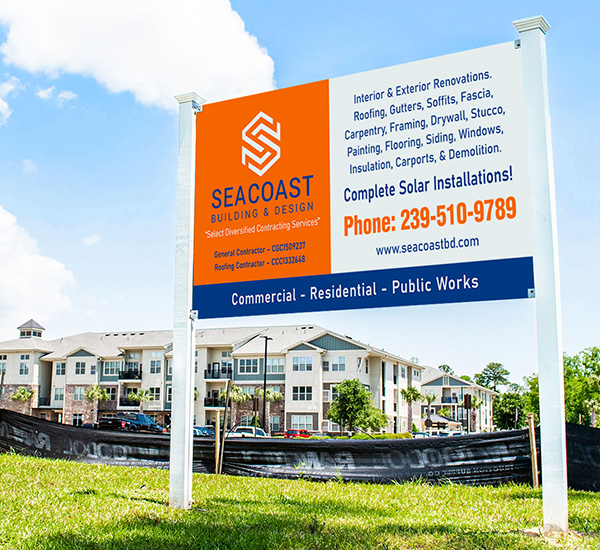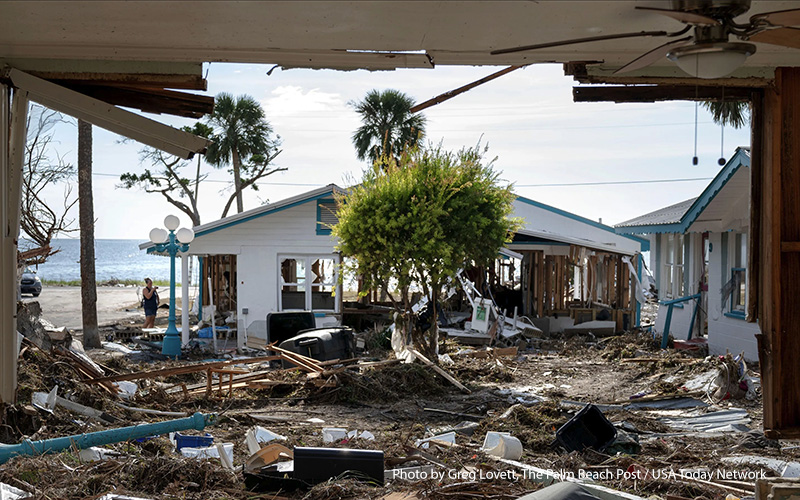December 15, 2024
Damage Caused by Storms
Not all hurricanes are created equal, but they can all inflict a certain level of damage to homes. Some of the most common post-storm roof repairs we make in Southwest Florida include fixing broken tiles or lost shingles. Other common issues include ruined gutters, shattered windows, and damaged exterior walls. Strong winds and flooding can also cause structural failures, such as shifting walls, floors, and ceilings.
Exterior damage compromises a home’s aesthetic appeal and can leave it vulnerable to leaks and deterioration. Even well-built properties are susceptible to a loss of structural integrity during powerful storms, and weaker structures are particularly prone to wind damage.
Fortunately, Seacoast Building & Design is well-equipped to quickly make the necessary repairs to restore homes after hurricane impacts.
Most Common Damage is to Roof
Some roof damage is inevitable in a storm. A hurricane is considered to have winds of 74 mph or greater, and it’s going to cause problems. Even the sturdiest roofs can suffer severe harm from high winds, including shingles being torn off or the entire system collapsing or lifting off. High wind speeds can uplift shingles and tiles and cause them to be torn away. Hurricanes rated Category 3 or higher can completely tear roofs off buildings, regardless of their age or condition.
Roof damage extends beyond just damaged shingles, sheathing, or framing. It can also expose the home’s interior to the elements, leading to water and structural issues. Even if visible signs of damage are not apparent after a hurricane, it is crucial to have a professional inspect the roof. This allows homeowners to identify and address problems before they escalate. You should have your roof checked for damage after severe weather events.
Structure and Foundation Damage
Hurricanes are nature’s fury unleashed, and their powerful forces can lead to severe foundation damage. The destructive potential of storms can be attributed to several factors. Hurricane wind speeds can range from at least 74 mph to 157 mph, which can be too much for your home’s foundation to handle. In some cases, an uplift can occur and wreak havoc on buildings. This happens when the wind flowing over the roof separates the house from its foundation.
As a homeowner or property owner in Florida, you know all too well the potential risks hurricanes pose to your property. In an uplift, the wind pressure can cause your home to tilt, rotate, or slide off its foundation. This movement can create new cracks or widen existing ones, making your house unstable and unsafe, compromising the structure’s structural integrity.
Hurricane Equipment Damage
Hurricanes bring the risk of flooding and powerful surges that can affect your structure’s equipment. These electrical surges may damage water heaters, HVAC systems, transformers, telephone lines, pool equipment, and other appliances. Depending on the severity of the surge, this damage can lead to malfunctions, reduced lifespans, or even fires. They can cause significant damage in extreme cases, like burnt circuit boards and even fires.
Flickering lights, sparking outlets, and burning smells are all signs of electrical damage. Great care needs to be taken when attempting to restore electrical systems and power to water-damaged equipment. Electrical equipment exposed to water can be extremely hazardous if re-energized without proper reconditioning or replacement. If you suspect your home or business has sustained electrical damage, turn off power to the affected area and contact a licensed electrician.
Interior Damage from Hurricane
Damaged windows and doors can allow flying debris, heavy rains, and high winds to enter your home, causing widespread interior damage. Your walls, floors, furnishings, essential documents, and other belongings may all be compromised. The stronger the hurricane, the more likely windows are to break or blow out entirely. Roofs may even be torn off, exposing interiors to water damage. However, prompt water extraction, drying, and restoration can help salvage your belongings.
The most common unseen damages from a hurricane may be difficult to notice, but they can do significant damage if left undetected and not repaired. Hidden issues, such as water infiltration behind walls and ceilings from roof leaks, can develop later. Other signs of wall water damage include collapsing drywall, cracks in walls, and peeling paint or wallpaper. Adjusters cannot rely upon a visual inspection alone.
Dangerous & Destructive Mold
Hurricanes often lead to a common problem: mold. The high humidity and moisture levels create ideal conditions for mold growth, which can develop within the first 72 hours. Signs of mold include a musty odor, visible growth on walls or ceilings, and discoloration or staining on surfaces. Once established, mold can leave behind stubborn stains and persistent musty smells that are difficult to clean.
Mold exposure can trigger serious health issues, including asthma attacks, eye and skin irritation, and other allergic reactions. If you have a weakened immune system or other health conditions, it’s recommended to consult your physician before attempting any cleanup. Consider enlisting professional mold remediation as soon as possible, as a certified team will be better equipped to address the contamination, resolve underlying moisture problems, and prevent the mold from returning.
Get Help Before and After a Hurricane
Recognizing the signs of hurricane damage in your business or home is crucial for minimizing harm and preventing further issues. Immediately addressing the damage is critical to safeguarding your building and the well-being of its occupants. Seacoast Building & Design professionals can help mitigate the impact when a hurricane strikes. Contact us to learn more about our hurricane recovery services before the next storm arrives.

Seacoast Building & Design
Office: (941) 500-5431
Hours of Operation:
Weekdays – 8 am to 6 pm
Saturday – 9 am to 3 pm
Or by Special Appointment.
Payment Methods:
Cash, Visa, Master Card, Amex, Discover, Invoice, Wire, ACH
Company Owners:
Clear & Chandra Dayland


